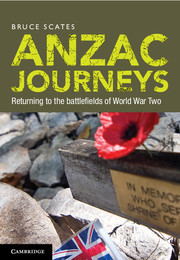Book contents
- Frontmatter
- Contents
- Maps
- Illustrations
- Acknowledgements
- Money, measurement and terminology
- Introduction
- PART 1 CAPTIVITY NARRATIVES
- PART 2 DESERT AND ISLAND
- PART 3 AIR AND SEA
- 8 Seeking the unknown: Remembering Sydney
- 9 Journeys into night: Bomber Command
- PART 4 AUSTRALIA'S FRONT LINE
- Conclusion
- Notes
- Index
9 - Journeys into night: Bomber Command
from PART 3 - AIR AND SEA
Published online by Cambridge University Press: 05 June 2013
- Frontmatter
- Contents
- Maps
- Illustrations
- Acknowledgements
- Money, measurement and terminology
- Introduction
- PART 1 CAPTIVITY NARRATIVES
- PART 2 DESERT AND ISLAND
- PART 3 AIR AND SEA
- 8 Seeking the unknown: Remembering Sydney
- 9 Journeys into night: Bomber Command
- PART 4 AUSTRALIA'S FRONT LINE
- Conclusion
- Notes
- Index
Summary
RAF Bomber Command squadrons were concentrated in Lincolnshire, in England's East Midlands. The principal targets for Bomber Command crews in 1944–45 ranged from the nearby areas of occupied northern France to the far eastern parts of Germany, including Berlin. In the latter case, a successful operation could take up to nine hours to complete, usually in darkness. More Australians were killed flying with Bomber Command, as a proportion of the over all force, than in any other theatre of World War II in which Australians took part.
Fixing the wings of an Avro Lancaster to its fuselage is never an easy task. In the dining room of an ageing farmhouse near Barham in southern New South Wales, a ‘Lanc’ lies on its back while Trevor T. fiddles with struts and screws to put the aircraft together. A musician and retired dairy farmer, Trevor indulges this pastime as secretary of the Cohuna Model Flying Club. After nearly 20 years work, this one-sixteenth scale model of Britain's most famous bomber of World War II is nearing completion.
Like his three friends and fellow club members looking on, Trevor's passion for flying machines was ignited half a century ago when Paul Brickhill popularised tales of wartime aerial daring in The Dam Busters (1951) and Reach for the Sky (1954).
- Type
- Chapter
- Information
- Anzac JourneysReturning to the Battlefields of World War Two, pp. 202 - 227Publisher: Cambridge University PressPrint publication year: 2013



